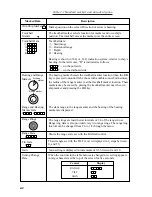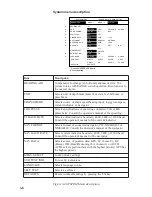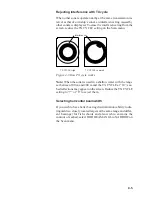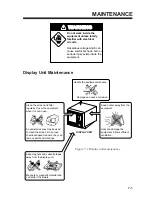
4-2
4. Locate a fish school on a long range setting which is ap-
proaching own ship. Adjust the tilt to keep the fish school in
the center of the sonar beam, namely, fish school is displayed
in strongest colors possible. Confirm that the fish echo is
displayed in the same color as it approaches. If the color sud-
denly changes to weaker colors as the fish enters FAR and
NEAR areas, the TVG is improperly set. Adjust the TVG. If
this again produces sea surface reflections and noise try to
remove them with AGC and NOISE LIM on the Scan menu.
5. Press the MENU key to close the menu.
Displaying Surface Fish Clearly
When you are searching for surface fish with the tilt set to a
narrow angle, sea surface reflections may disturb or mask wanted
fish echoes. In this case, in addition to the TVG adjustment de-
scribed earlier set the AGC between positions “0” and “3” on
the Scan menu.
Suppressing Seabed Tail
As noted earlier, fish schools (echoes) located near the seabed
are sometimes difficult to detect because you have to discrimi-
nate them in the seabed reflections. The AGC and
PULSELENGTH in the Scan menu, if used properly, decrease
the tail of seabed reflections, making it easier to discriminate
bottom fish.
AGC
The AGC functions to automatically reduce the receiver gain
only against strong echoes such as the seabed or a large fish
school. Since weak echoes remain unaffected, a small fish school
becomes easier to detect. Adjust it so that the AGC works only
on seabed reflections. Do not set it too high; weak echoes may
be missed.
Pulselength
The pulselength control determines the length of the transmis-
sion pulse emitted into the water. While a longer pulse is advan-
tageous for long range sounding, it has the disadvantage of being
poor in discrimination of targets, that is, ability to separate sev-
eral closely located targets. When searching bottom fish, there-
fore, it is useful to shorten the pulselength in order to separate
Содержание CSH-7
Страница 1: ...COLOR SCANNING SONAR MODEL CSH 7 ...

































